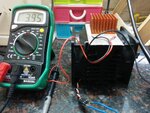gauravkothari23
Advanced Member level 2

Hi all.
I am trying to build a small cooler using peltier module 12706, as the image attached. i have connected the module to 12v 10 Amps power supply. the consumption of current is around 4 amps at 12v. also connected a Hugh heatsink with two fans on the hot side using a thermal greece, and a small heatsink on a cold side. the temperature on the hot side is around 32 degree Celsius. but the cold side is not getting cooler. the lowest temperature i am getting is around 11 to 12 degree Celsius.
what's wrong with it. can anybody please help me.
I am trying to build a small cooler using peltier module 12706, as the image attached. i have connected the module to 12v 10 Amps power supply. the consumption of current is around 4 amps at 12v. also connected a Hugh heatsink with two fans on the hot side using a thermal greece, and a small heatsink on a cold side. the temperature on the hot side is around 32 degree Celsius. but the cold side is not getting cooler. the lowest temperature i am getting is around 11 to 12 degree Celsius.

what's wrong with it. can anybody please help me.








